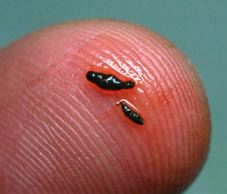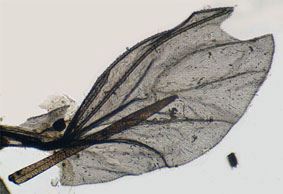|
home: www.rubythroat.org |
|
|
home: www.rubythroat.org |
|
Although many people think the Ruby-throated Hummingbird, Archilochus colubris, is exclusively a nectar-eater, since most nectar contains only sugars (carbohydrates) it would not comprise a well-balanced diet. As a warm-blooded vertebrate, hummingbirds also need to ingest proteins that can be converted into muscle, feathers, and other body parts. Fats are also necessary, particularly as hummers store energy in preparation for lengthy migratory flights.
|
|
This female Ruby-throated Hummingbird (left) has a YELLOW throat, but only because she has been feeding heavily on flowers loaded with yellow pollen. |
| Another Ruby-throated Hummingbird (right) shows an extremely heavy deposit of pollen on its crown--so much that it almost appears to be painted on. This pollen is likely from Trumpet Creeper, Campsis radicans, a common but very important native hummingbird flower in the eastern U.S. |
All photos & text © Bill Hilton Jr. |
Ruby-throated Hummingbirds (RTHUs) also take advantage of "sapsucker wells," a series of small holes in tree trunks (left photo) drilled by various species of North American woodpeckers (e.g., Yellow-bellied Sapsucker). These holes ooze sap--a source of tree sugars--and also attract small insects. Especially in early spring before many plants have flowered, hummingbirds visit sapsucker wells to lap up the sap and catch the protein-rich flies and gnats that congregate there.
D.V. Austin (1975) reported that RTHUs apparently help pollinate at least 31 species of plants in their North American breeding range, at least 19 of which have coevolved with hummingbirds as their primary pollinators. RTHU are innately curious and constantly explore their feeding territories for nectar sources that change not only week to week but even hour to hour.  Even when a dependable, super-rich energy source such as a hummingbird feeder hangs within a feeding territory, the resident hummingbird still visits nearby flowers and captures insects. Hummingbirds are attracted to red flowers, probably not because they see red better but because so many hummingbird-pollinated flowers that hold heavy nectar loads are red. The red itself may have been selected for in plants because it is the visible color that contrasts most conspicuously against a background of green foliage.
Even when a dependable, super-rich energy source such as a hummingbird feeder hangs within a feeding territory, the resident hummingbird still visits nearby flowers and captures insects. Hummingbirds are attracted to red flowers, probably not because they see red better but because so many hummingbird-pollinated flowers that hold heavy nectar loads are red. The red itself may have been selected for in plants because it is the visible color that contrasts most conspicuously against a background of green foliage.
There's no question that hummingbirds make use of plant nectar--or the sugar water from your feeders--as a source of quick energy. But while they're visiting those flowers, they may also be gobbling up tiny insects and spiders--both excellent sources of protein. In fact, some authorities think of hummingbirds as insectivorous birds that happen to also eat plant nectar. Some studies have even shown that on their wintering grounds in the tropics, hummingbirds may eat far more insect matter than plant nectar.
The two photos below are proof that hummingbirds eat insects. At left, a drop of RTHU feces--clear liquid in which are floating two dark specks--sit on the tip of the bander's finger. The dark specks are indigestible insect parts, and at right is a photomicrograph of this same fecal droplet showing the wing of a tiny sciarid gnat the hummer had eaten!
 . . .
. . . 
All photos & text © Bill Hilton Jr.
Although some observations have been made in the tropics on foraging habits of RTHUs, considerable work still needs to be done. To this end, Operation RubyThroat participants have taken ten trips to Costa Rica and one to Belize to study RTHUs on their wintering grounds in Central America. Complete accounts of these expeditions are linked from Ruby-throated Hummingbirds in Costa Rica. Note that more excursions are planned for future years for "citizen scientists" such as yourself.
Go back to Reproductive Behavior; forward to Ecological Relationships
Up to Top of Page
|
Make direct donations on-line through
Network for Good: |
 |
|
LIKE TO SHOP ON-LINE?
Donate a portion of your purchase price from 500+ top on-line stores via iGive: |
|
|
Use your PayPal account
to make direct donations: |
|
|
|
Share Your Hummingbird Experiences Through "Hummingbird Hobnob" |
 |
Operation |
|
|